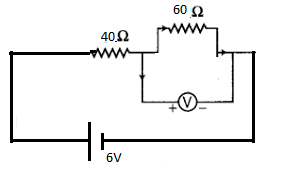
The reading of the voltmeter of the circuit shown in the figure is:

A) 3.6V
B) 3.25V
C) 4.25V
D) 6.25V
Answer
217.8k+ views
Hint: We will apply KVL(Kirchhoff's Voltage Law) in the given circuit to find out the unknown current flowing in the circuit because resistors connected in the circuit are in series. Voltage across 60 ohm resistor is equal to the product of the current flowing through the circuit and the given resistor of 60 ohm, which is termed as OHM's Law.
Complete step by step solution:
Now let’s apply the KVL in the circuit, which states that:
“Sum of all the voltage drops in the circuit is equal to zero “.
Let the unknown current flowing in the circuit is i, which we have to find out :
Before proceeding for the problem , we must learn about sign conventions of KVL law :
If we move from positive to negative sign then voltage is dropped then we will use negative sign while applying KVL ,If we move from negative to positive sign then voltage is grained then we will use positive sign in the equation .
In series connection current remains the same in all the circuit elements but voltage will be different and hence we will find out the current to find out the voltage across the voltage meter, as voltmeter measures the voltage across the element to which it is connected.
Let's proceed for the problem:
KVL law is applied as:
$ \Rightarrow 6 - 40i - 60i = 0$
$
$\Rightarrow 6 = 100i$
$\Rightarrow i = .06 $
$ (we have arranged the terms and find the value of i)
Now the value voltage across 60 ohm resistor is given by OHM'S Law (V=IR)
$ \Rightarrow V = i \times 60$
$ \Rightarrow V = .06 \times 60 = 3.6V$
Voltmeter reading is 3.6Volt.
Note: Ammeter measures the magnitude of current flowing in the circuit and always connected in series in the circuit . Voltmeter measures the magnitude of voltage drop across the connected circuit and is always connected in parallel in the circuit. When resistors are connected in series , the given magnitudes are added directly without taking reciprocal value to find an equivalent resistor in the circuit.
Complete step by step solution:
Now let’s apply the KVL in the circuit, which states that:
“Sum of all the voltage drops in the circuit is equal to zero “.
Let the unknown current flowing in the circuit is i, which we have to find out :
Before proceeding for the problem , we must learn about sign conventions of KVL law :
If we move from positive to negative sign then voltage is dropped then we will use negative sign while applying KVL ,If we move from negative to positive sign then voltage is grained then we will use positive sign in the equation .
In series connection current remains the same in all the circuit elements but voltage will be different and hence we will find out the current to find out the voltage across the voltage meter, as voltmeter measures the voltage across the element to which it is connected.
Let's proceed for the problem:
KVL law is applied as:
$ \Rightarrow 6 - 40i - 60i = 0$
$
$\Rightarrow 6 = 100i$
$\Rightarrow i = .06 $
$ (we have arranged the terms and find the value of i)
Now the value voltage across 60 ohm resistor is given by OHM'S Law (V=IR)
$ \Rightarrow V = i \times 60$
$ \Rightarrow V = .06 \times 60 = 3.6V$
Voltmeter reading is 3.6Volt.
Note: Ammeter measures the magnitude of current flowing in the circuit and always connected in series in the circuit . Voltmeter measures the magnitude of voltage drop across the connected circuit and is always connected in parallel in the circuit. When resistors are connected in series , the given magnitudes are added directly without taking reciprocal value to find an equivalent resistor in the circuit.
Recently Updated Pages
Apparent Frequency Explained: Formula, Uses & Examples

Calorimetry: Definition, Principles & Calculations

Centrifugal Force Explained: Definition, Formula & Examples

Charge in a Magnetic Field: Definition, Formula & Examples

Charging and Discharging of a Capacitor Explained Simply

Combination of Capacitors: Series and Parallel Explained

Trending doubts
JEE Main 2026: Application Form Open, Exam Dates, Syllabus, Eligibility & Question Papers

Derivation of Equation of Trajectory Explained for Students

Hybridisation in Chemistry – Concept, Types & Applications

Understanding the Angle of Deviation in a Prism

Understanding Collisions: Types and Examples for Students

How to Convert a Galvanometer into an Ammeter or Voltmeter

Other Pages
JEE Advanced Marks vs Ranks 2025: Understanding Category-wise Qualifying Marks and Previous Year Cut-offs

Understanding Atomic Structure for Beginners

Ideal and Non-Ideal Solutions Explained for Class 12 Chemistry

Degree of Dissociation: Meaning, Formula, Calculation & Uses

Understanding Electromagnetic Waves and Their Importance

Understanding the Electric Field of a Uniformly Charged Ring




